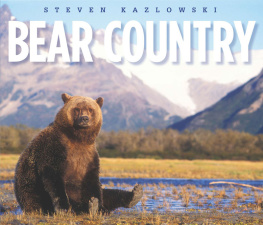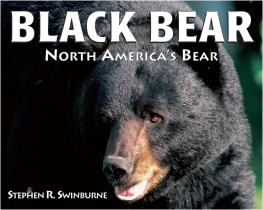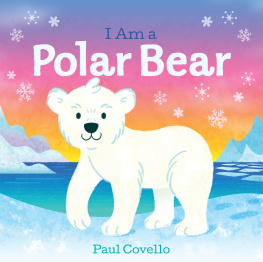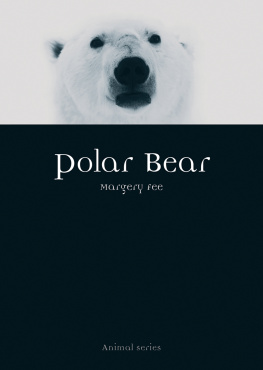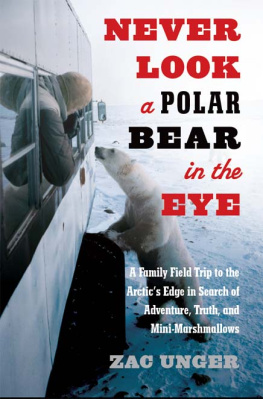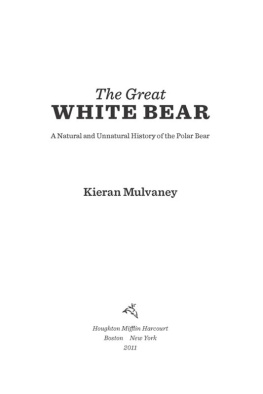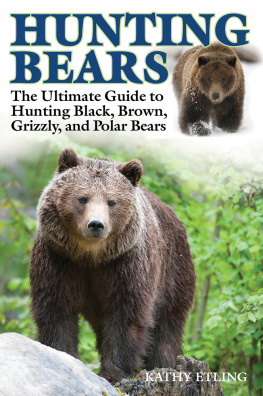



To Jack Kayotuk, my good buddy, who always has a big smile on his face and a laugh in his belly.
To Bruce Inglangasak, my other good buddy, for his understanding of traveling safely, his willingness to help me on many occasions, and his many long stories, which have made many months pass quickly over the years.
To Fred Kaleak, for his friendship and for sharing his love and his familys love for the polar bear with me way back when.

| THE MOUNTAINEERS BOOKS is the nonprofit publishing arm of The Mountaineers, an organization founded in 1906 and dedicated to the exploration, preservation, and enjoyment of outdoor and wilderness areas. |
1001 SW Klickitat Way, Suite 201, Seattle, WA 98134
Photographs and text 2012 by Steven Kazlowski
First edition, 2012
All rights reserved
No part of this book may be reproduced in any form, or by any electronic, mechanical, or other means without permission in writing from the publisher. Distributed in the United Kingdom by Cordee, www.cordee.co.uk
Manufactured in China
Developmental editor: Christine Clifton-Thornton
Book design and layout: Jane Jeszeck, Jigsaw / www.jigsawseattle.com
COVER: Young female grizzly bear wakes up from a nap and stretches her leg, doing bear yoga before she starts another afternoon of fishing. Chugach Bay, Alaska
PAGE 1: A young black bear boar, Olympic National Park, Washington
FRONTISPIECE: A polar bear sow and cub during fall freeze-up, Arctic coast, Alaska
PAGE 3: A grizzly bear sow at sunrise, Katmai National Park, Alaska
THIS PAGE: A young blond grizzly bear, Katmai National Park, Alaska
Library of Congress Cataloging-in-Publication Data on file
ISBN (hardcover): 978-1-59485-675-4
ISBN (ebook): 978-1-59485-676-1

Contents
INTRODUCTION

BEARS SYMBOLIZE THE WILD. There is something inherent in all of us that connects us to the wild, and observing bears allows us to truly see that sense of wild that we find so spellbinding. Something about the beautiful, strong, majestic bear tugs at a string deep inside of us, reminding us that we, too, were once creatures who lived free. Bears might even stir up a bit of envy on our part. We are often attracted to the way in which bears seem to inhabit the landscapethey know who they are, they know what they want to do, and there is very little confusion about it. Bears share many of the same drives for life we do: the desire for food, shelter, and happiness. In the following pages youll find an intimate look into the lives of black bears, grizzly bears, and polar bears through my experiences while photographing them over the course of fifteen years.
BEAR SPECIES
Bears are mammals of the family Ursidae. They are classified as caniforms or carnivorans, with the pinnipedfin-footed mammals such as sealsbeing their closest living relatives. There are eight species of bears in the world: the Asiatic black bear, black bear, brown bear, panda bear, polar bear, sloth bear, spectacled bear, and sun bear. Three of these species are found in North America: black bears (Ursus americanus), brown (grizzly) bears (Ursus arctos), and polar bears (Ursus maritimus).
Black Bear
Black bears are found in all types of terrain, from the southern United States to northern Canada and Alaska, and from the Smoky Mountains to the Rockies, in geography as diverse as the high desert of Nevada to the glaciers of Alaska. Because there are more documented human attacks by black bears than by any other bear species, its often thought that people have more problems with black bears than with other bears. This is undoubtedly the result of a single fact: There are more American black bears in the world than all other bears on Earth combined, with a total population of nearly one million.
The fur color of the black bear ranges from deep black to cinnamon to blue to the white fur of the spirit, or Kermode, bear. This makes black bears a diverse photographic subject. The black bear possesses an uncanny ability to adjust toand disappear intourban settings. Where I live now, on the Kitsap Peninsula in Washington State, black bears are present, but other than occasional tracks, I rarely spot them because of their ability to blend into the landscape. They have even been spotted within nearby Seattles city limits, an urban center of more than 600,000 people!

Black bear spring cub, Tongass National Forest, Southeast Alaska

Black bear, Kenai Fjords National Park, Southcentral Alaska

Grizzly bear sow, Katmai National Park, Alaska
AVERAGE BEAR WEIGHT IN POUNDS
SPECIES | MALE | FEMALE |
Black | 250400+ | 120300 |
Grizzly | 5501,000+ | 220450 |
Polar | 8001,600+ | 400800 |
The black bear is the ambassador bear of all bears. Because they are so widely distributed in North America, black bears offer the best chance for people to understand bears through observation. If you have an interest in seeing bears, you will most likely be able to find a location to view a black bear more easily than any other bear. Black bears are the ghosts of our forests, and their presence makes our woods richer. They have found their way, as the coyote has, to live in the footprint of man as well as in the wild.
Brown (Grizzly) Bear
Brown bears, also known as grizzly bears in some regions, can be found in areas of the northwestern United States, western Canada, and Alaska, as well as eastern and western Eurasia. They are the most widely distributed bear species in the world, with an estimated world population of about 200,000. They were once a powerhouse species in North America. At the time of Lewis and Clarks expedition across the American West, it is estimated that there were up to 100,000 grizzly bears in the contiguous United States alone. Today, fewer than 1,200 grizzlies survive in protected parks and wilderness areas within the Rocky Mountains of Wyoming, Idaho, and Montana, as well as in Washingtons North Cascades. Due to expansion of human settlement, these animals have lost most of their former habitat and persist only in areas where their space and food needs are met, such as Alaska, where more than 70 percent of the North American population is found. Brown bears were listed as threatened under the federal Endangered Species Act in 1975.
Next page
